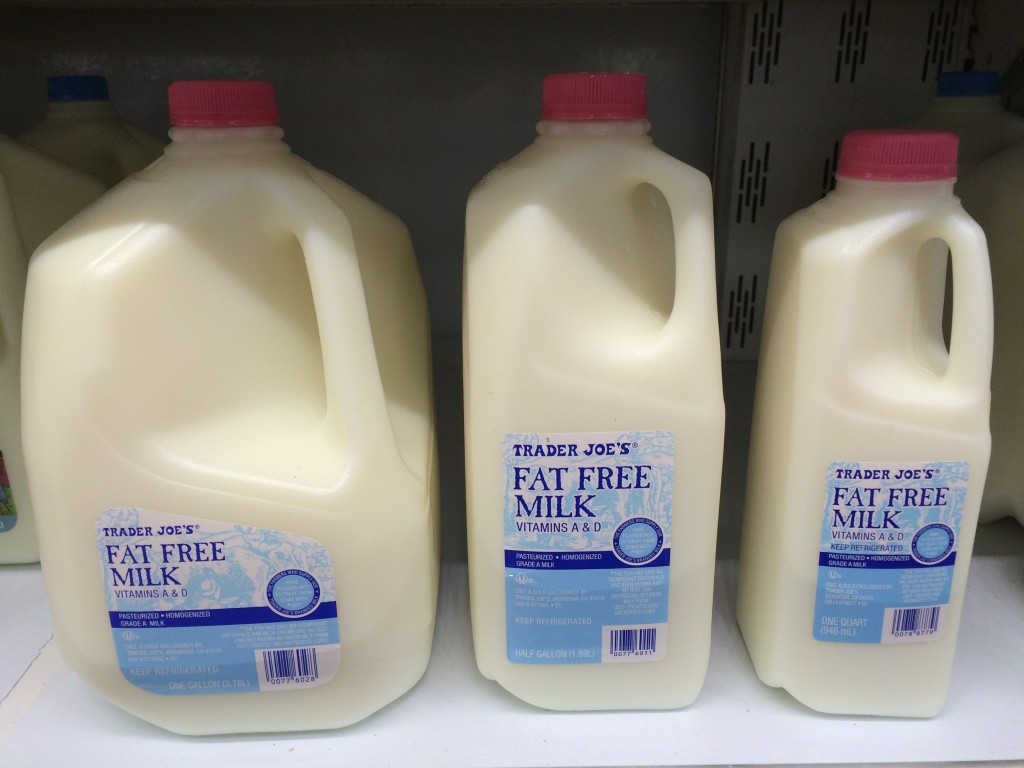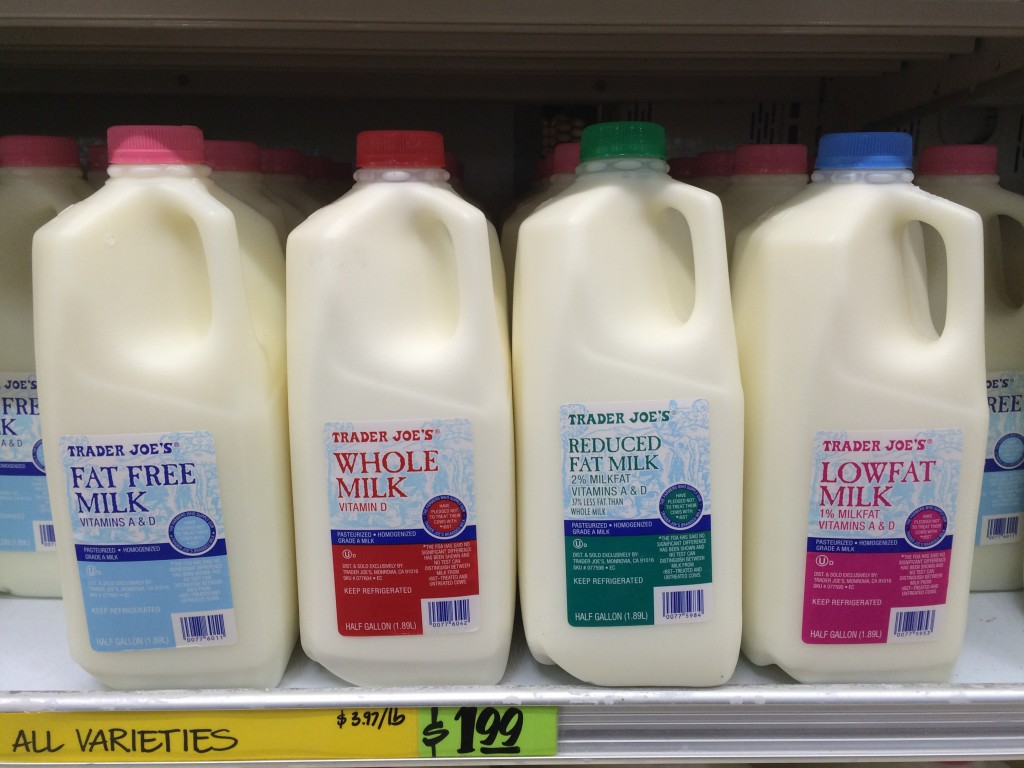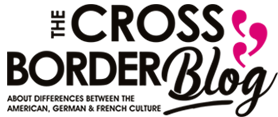
Milk: Differences between France and the USA
It’s not always easy to manage cultural differences in your daily routine, but there are also differences with the products and services you use in everyday life. The detergents are different, as are the maternity leaves and the summer camps. There may be products that can’t be found, a service that’s completely different, or even crazy prices. Once or twice per month, I will now discuss these practical matters, so feel free to share some ideas with me! For today, let’s talk about milk in the United States.
All expats know this feeling when they go shopping elsewhere for the first time. Honestly, I would never have thought that filling my shopping cart in the United States would take so much time. Yes, of course I knew that Americans didn’t eat the same foods as us. And yet…
Having worked in international marketing all my life, modifying umpteen product packages for markets in France, the Netherlands, Italy, etc., I didn’t expect to be shocked while perusing the shelves.
Let’s get back to milk. In Germany, where I was living before 2013, I would buy semi-skimmed milk, which happens to be a French favorite. Buying the same kind of milk here hasn’t been as easy as I would have thought.
The size of milk bottles in the United States
At first I was amazed by the size of the bottles: the standard size is the gallon, which is 3.8 liters. At the end of the day, I like this a lot as our family goes through a lot of milk.
Between breakfast cereal, muesli in the afternoon (my oldest daughter after school) and homemade chocolate creams, we need about 2 gallons of milk per week. There’s no need to return to the supermarket during the week, as my fridge is big enough for eight liters (2 gallons) of milk!

The fat content in American milk
After discovering the advantage of the larger bottles, I had to learn about the differences. Americans have the choice of four levels of fat. They have whole milk and skim milk like in France, in addition to two kinds of semi-skimmed milk. In France, semi-skimmed has 1.5% in fat. Here, we can choose between 2% (reduced fat) and 1% (lowfat).
French people can choose between whole milk and skim milk only.
Milk cap color codes in the United States
The color codes are also different. In both France and the United States the red cap is used for whole milk, but the other colors vary completely. Although having two varieties of semi-skim milk justifies having an extra color, I admit I draw a blank as to why there are two different colors for the same product. For example, the cap for American skim milk can be pink or light blue.
France-USA: Milk Color Code Comparison
| USA | France | |
|---|---|---|
| Whole milk (3.5%) | Red | Red |
| Reduced fat milk (2%) | Blue | |
| Semi-skim milk (1.5%) | Blue | |
| Low fat milk (1%) | Yellow or purple | |
| Skim milk (0%) | Pink or light blue | Green |

There is no UHT milk in the United States!
Finally, one notable difference for most French people is that the milk here is not UHT but freshly pasteurized. You buy it in the dairy section, like in Germany. According to this article in French Morning:
“In France, more than 90% of milk consumed is UHT (pasteurized at Ultra High Temperature), … However in the United States, 90% of the milk sold undergoes only simple pasteurization. Therefore it must be constantly refrigerated and only lasts for about two weeks.”
It’s not exactly two weeks. Since 2009, a new technique allows milk to be kept fresh for a few weeks, however it doesn’t last as long as long-life milk. The fact remains that milk is kept in the fridge and it doesn’t taste like UHT milk.
Why is there no UHT milk in the United States?
In the same French Morning article, the former CEO for Lactalis in the United States provided an answer:
“The famous “milkman” is a piece of American history. Americans grew up with the tradition of fresh milk being delivered to their homes” pointed out Paul Bensabat, former CEO of Lactalis in the United Sates, and founder of Saveur Food. Since fresh milk can only be kept in the refrigerator, Americans can only imagine drinking milk if it comes out of the fridge.”
It should be noted that UHT milk isn’t completely absent from the American market. My children sometimes bring small packages of chocolate or vanilla milk to school.
Conclusion
In 2013, Americans drank 20 gallons of milk on average compared to 14.2 gallons in France. I’m going to go into German mode here (don’t forget I hold dual citizenship) and I’m going to nitpick these figures a little bit:
20 gallons, that’s about 6.7 ounces per day, per person, which is about 1.5 quarts per week, per person. For a family of five, like mine, that’s about 1.8 gallons consumed each week. My two gallons of milk come in handy!
My husband and I can never agree when we talk about milk. I believe that milk is healthy, especially for the children. For the same reason, he prefers eggs for breakfast. In his opinion, milk is indigestible, with the proof being that Asians only consume very little.
We are probably both right. But since I’m the mother, my children eat cereal every weekday morning. I let their father handle the weekend, when they can have eggs and bacon on their plates. And of course, I would never draw a comparison, no, because eggs and bacon are not heavy whatsoever… right?




Milk is god,i lowe milk
Came here to bust the myth that Asians drink little milk and that Asians are lactose intolerant. In the real world, Asians drink a lot of milk. Japanese kids (it is rumored that) got boosts in their height through a couple of generations drinking copious amount of milk. Milkmen was a common phenomenon in old time China (pre 1990). We used to get daily delivery of milk (2 small bottles). Government even subsidized milk consumption by families.
So the whole idea that Asians don’t drink milk because we are lactose intolerant is not a real problem in real life, only exist outside of Asia. Growing up in Asia, Asians don’t drink milk or are lactose intolerant is unheard of.
I only learned about lactose intolerance existed after I left Asia and moved to Europe. And anecdotally, the only people I know who are lactose intolerant are Jewish, none of my Asians friends are lactose intolerant.
You have no idea how big of a help you just brought to me n my kids. On vacation in Paris France. I went to buy cereal n milk but milk was outside the fridge and container was a carton not plastic so I panic and placed the cereal back. Promised the kids I would search for milk tomorrow. With this article my search would be a lot easier and I won’t panic again. Thank you so much !!
You are very welcome. Enjoy Paris and the Music Festival (Fête de la Musique) on Friday!
A lot Asians are latose intolerance. We will drink soy milk, or horse milk depending in what country you’re living in. We aren’t as milk caution as some Americans. Too Americans go overboard. You don’t have to drink milk to get calcuim. You also have cheese, yogurt, or kerfir.
I am a milk, drinker as older Americans are supposed to drink at least 3 glasses of milk (24 oz) per day. Look at the epidemic of osteoporosis in America because of low calcium intake. And milk is still a lot better than 5 lbs of chard to get that calcium. I live in France, between Brittany and Paris at least 3 months a year. Fresh milk is in every supermarket that I’ve been in. You’ll notice that Parisians are slighter build, don’t mean just slimmer, as they certainly are slimmer than Americans. Yes, the French historically drank less milk than Americans and the cities had less milk available because they had little refrigeration in the past. In Paris there were goats on ropes and should an apartment dweller need fresh milk they’d yell to the goat owner to send up the goat! Goats naturally keep going up and when they got to the etage (floor) the dweller would milk a liter of milk, pay their francs in a pay-collar and send the goat down. So you see, milk was hard to come by. Parisians got their calcium in cheese and yogurt, which didn’t require refrigeration. It wasn’t so much a preference, but a necessity. Cultural norms are hard to drop.
Asians actually do like milk and now are able to enjoy more milk in their diets. In the past there just weren’t many milk cows in China, etc. To get protein Asians had pigs and chickens because they took up less land, more efficient than huge cows in pastures, thus less milk available. Now they can get imported milk, the ultra pasteurized kind that can be shipped.
What a great comment! I didn’t know half of it. Thank you Brenda!
It’s amazing to see such differences on products as simple as milk. I was already told by American or English friends that French milk taste “funny” (i.e. they really didn’t like it!).
I only buy 2L of milk per week (we are 3), far below your huge 2 gallons!
Just a little mistake on your post: you’ll find 03 different type of milk in France: skim milk was forgotten (max 0,5), with a green cap. (And, of course, you’ll find organic milk in every food stores, but without specific cap color.)
You’re right Lucile! Sorry for forgetting this. I remmber that my mum used to drink skim milk, which was kind of looking like painted white water. Not very tasty… One more point: there is also “raw milk” in France = unpasteurized, uncooked milk.